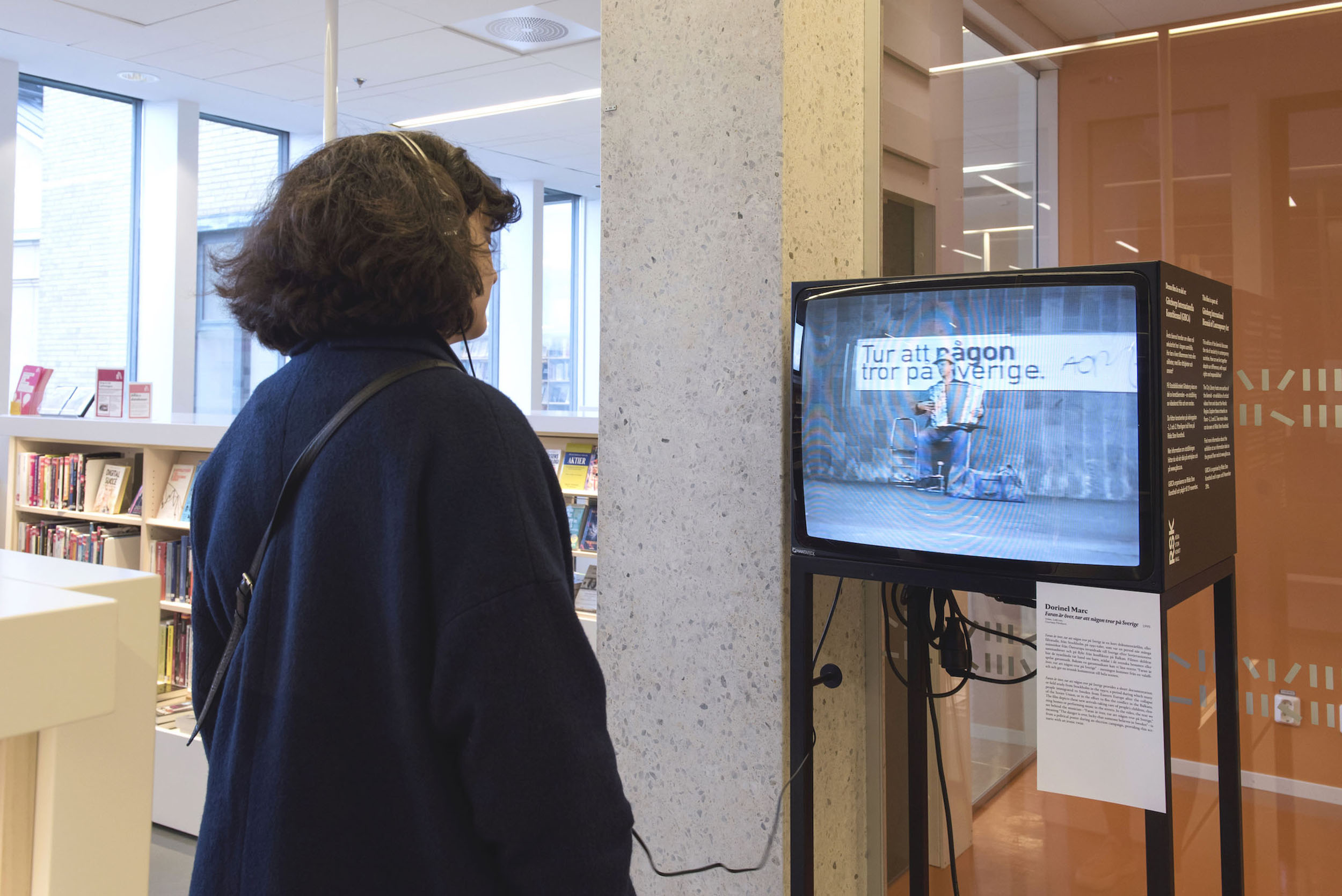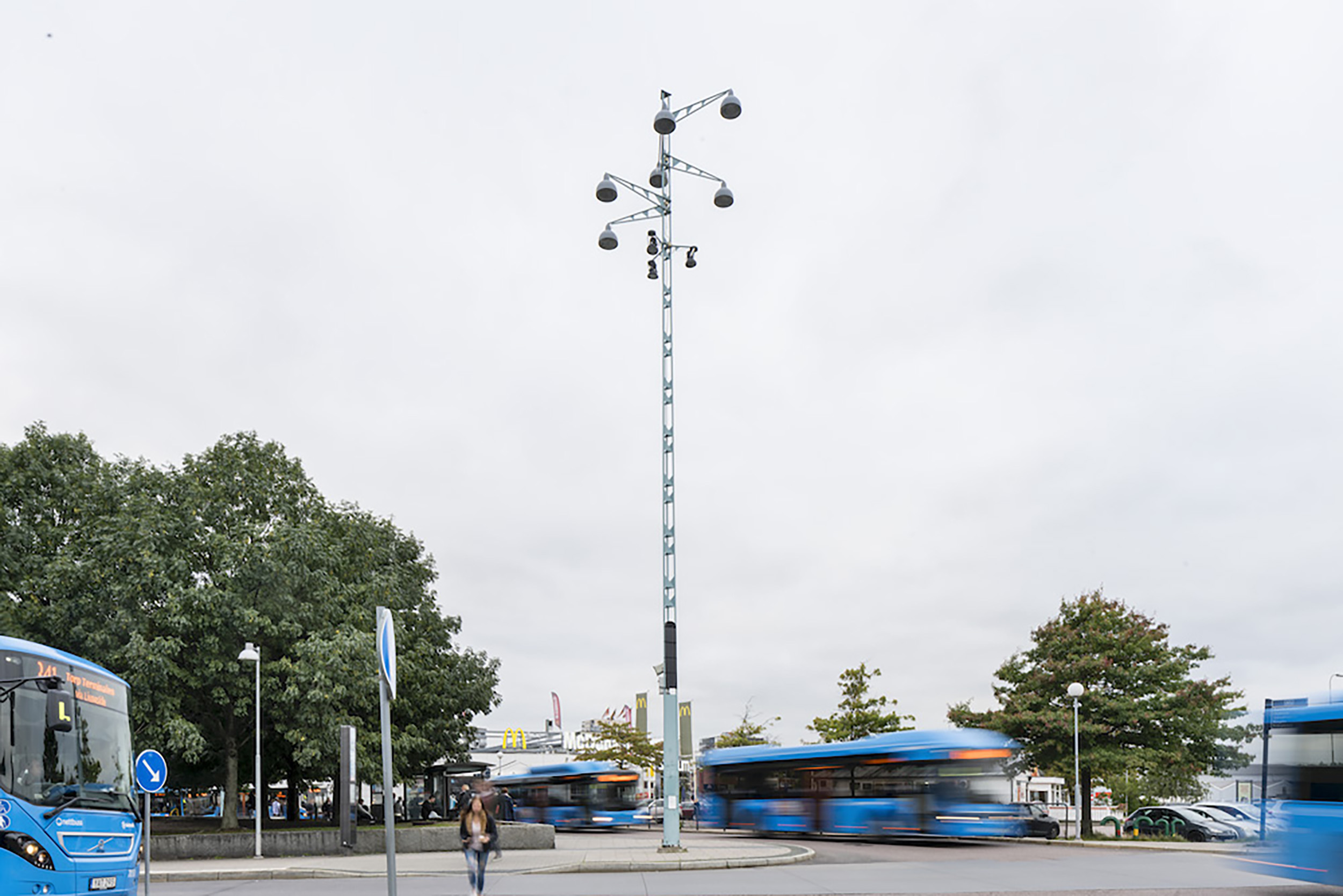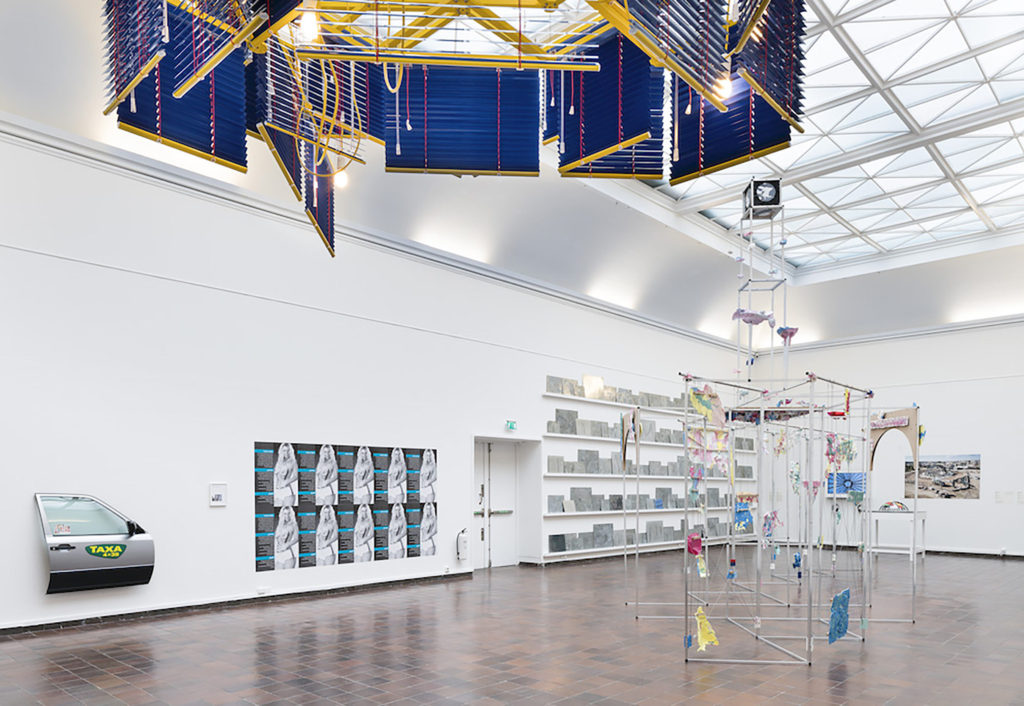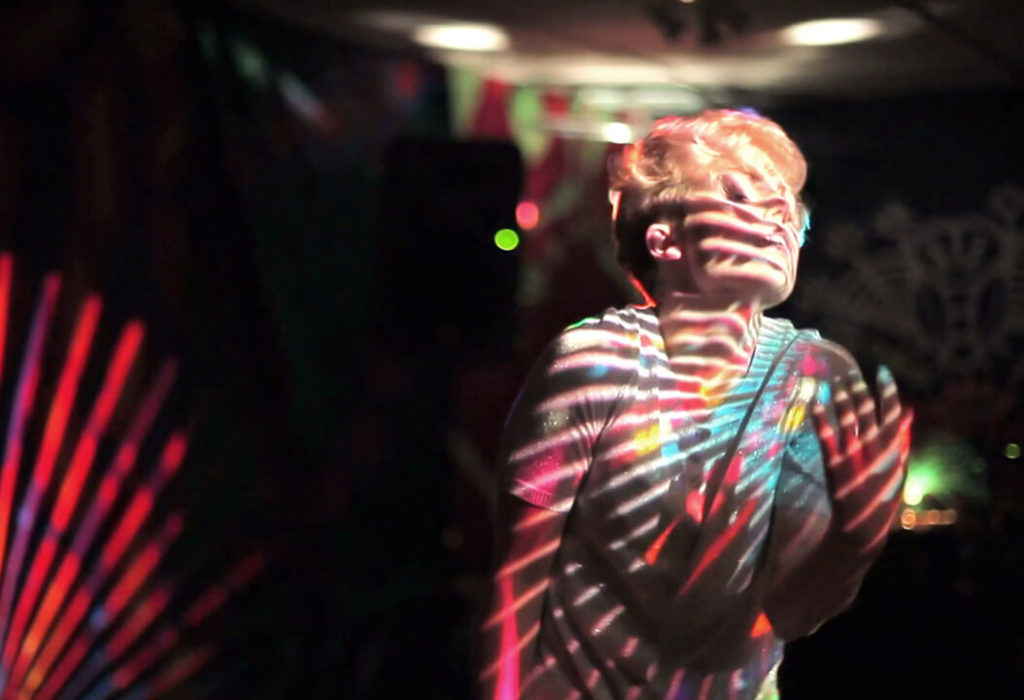NAV HAQ
Notes on WheredoIendandyoubegin – On Secularity
- 17.12.2018
Santiago Mostyn, Citizen (video stills), 2017. Two-channel HD film, wooden oars, framed archival inkjet print. 312 minutes. Stills courtesy of the artist and Andréhn/Schiptjenko, Stockholm
Göteborg International Biennial for Contemporary Art 2017
The invitation to work on the 2017 edition of the Göteborg International Biennial for Contemporary Art (GIBCA) was an opportunity to further develop an idea that had been germinating for some time. I had been thinking about the question of atheism, particularly the plurality of non-belief and the different positions of non-believers towards a multifaith society. This led me ultimately to secularity, drawing the concept away from questions of non-faith or even faith, towards something more complex. Liberal secularity is about creating the conditions for the coexistence of different ‘modes of living’ by legally providing individuals with social protections and freedoms. I take the phrase ‘modes of living’ from Judith Butler, whose work was particularly inspiring when researching this subject.1
Santiago Mostyn, Citizen (video stills), 2017. Two-channel HD film, wooden oars, framed archival inkjet print. 312 minutes. Stills courtesy of the artist and Andréhn/Schiptjenko, Stockholm
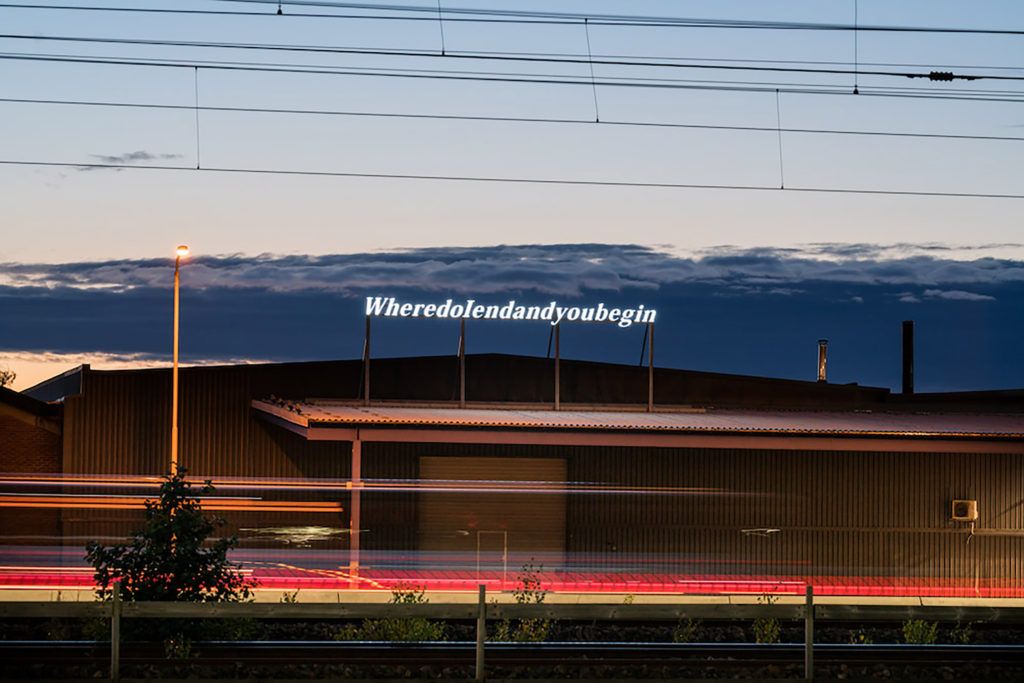
Shilpa Gupta, WheredoIendandyoubegin, 2012, LED-based light installation. 880 x 68 cm. Produced with the support of “Mixed Bathing World,” Beppu, Japan. Installation view GIBCA 2017 WheredoIendandyoubegin – On Secularity. Photo: Hendrik Zeitler
Though the term ‘secularity’ itself may seem abstract to many, it is a concrete part of everyday experience in many societies. Typically manifested through the separation of organised religion and state, secularity has played an essential role in creating the conditions for regulating complex and often divisive sociocultural issues, including sexual freedoms, gender equality, minority rights, freedom of religion and freedom of expression. The first part of the title of the biennial – WheredoIendandyoubegin – taken from Shilpa Gupta’s namesake work, seemed to resonate succinctly with the notion of secularity understood as a reflection on the make-up of society, the tensions between private and public, individual and collective, and the fullness of one person’s rights and freedoms in uninhibiting relation to those of another.
Secularity can be seen as a mode of ethics in a pluralistic society. Ultimately it is about seeking equality in cohabitation, where notions of difference can be used as the parameters from which to measure equality. Yet, the status of secularity has become increasing precarious in these turbulent times, even in places once considered socially liberal and tolerant. Indeed, secularity seemed an increasingly topical issue during the period when I worked on the biennial.
Today, by contrast, there seems to be growing numbers of people in different corners of the globe, from the USA and the Netherlands to Myanmar and the Nordic countries, who feel their society shouldn’t be pluralistic, but the reality is that it intrinsically is, and probably always was. When empowered through electoral channels or media visibility, these identitarian movements deploy ideological visions of a nationalistic monoculture that pose a fundamental challenge to pluralism and therefore to the principles of secularity. For this reason, it felt important to identify key questions: How can we sustain freedoms – social, sexual, cultural, religious or atheist – in a context of stark cultural differences? What do we mean by ‘non-belief’ and ‘belief’ today? Is secularity still to be defined by the state? If not, by whom?
While GIBCA is not a biennial megastructure, it does have the ambition to contribute to discourse at the intersection of art, politics and philosophical thought. Biennials often aim to address a global audience, an attempt that can be somewhat absurd. The scale of GIBCA meant that its subject needed to be specific without being one-dimensional. It also felt more relevant to privilege a Nordic pegging, as I sought to address some fundamental questions about civil society in Europe, the formalisation of its values and the fine line between protection and violence.
Gothenburg itself is increasingly considered one of the most segregated places in Europe. Suburban social-housing districts such as Hammarkullen, resulting from the Swedish Miljonprogrammet (Million Programme)2 in the social-democratic heyday of the mid-1960s to the mid-1970s and now densely populated with migrants from around the world, are at once hotbeds of radicalisation and enclaves of futuristic cultural autonomy outside of the mollycoddling of the welfare state. This, together with the presence of neo-Nazi groups such as the Nordic Resistance Movement in the region3 and an imminent general election in which the far-right ultranationalist Sverigedemokraterna (Swedish Democrats) are poised to make significant gains, all adds up to a rather troubling environment. These factors were impossible to ignore: they became a motivation for a biennial addressing the myth of national monoculture through the notion of secularity.
Shilpa Gupta, WheredoIendandyoubegin, 2012, LED-based light installation. 880 x 68 cm. Produced with the support of “Mixed Bathing World,” Beppu, Japan. Installation view GIBCA 2017 WheredoIendandyoubegin – On Secularity. Photo: Hendrik Zeitler

Installation view GIBCA 2017 WheredoIendandyoubegin – On Secularity at Röda Sten Konsthall. Photo Rebecka Bjurmell
Installation view GIBCA 2017 WheredoIendandyoubegin – On Secularity at Röda Sten Konsthall. Photo Rebecka Bjurmell
The choice of the term ‘secularity’ – and not ‘secularism’ – was a clear decision. Secularism is ideological, as in the concept of laïcité in the constitution of France. By contrast, secularity offers something more open, a space for negotiation and, in this case, artistic invention. The core of the biennial was the works of some 30 artists, who brought a multiplicity of perspectives on this subject. Alongside the many works presented at the art spaces Röda Sten Konsthall and Göteborgs Konsthall, GIBCA had the capacity to commission and present new site-specific projects along with existing works at different locations around the city.
For example, Gupta’s WheredoIendandyoubegin was presented in the industrial no man’s land of Gamlestaden located between the city centre and the largely underprivileged northern suburbs. Visible primarily to commuters on the tram journey between periphery and centre, the large LED text work posed its rhetorical question to passengers, highlighting the spatially segregated nature of Gothenburg.
Two sections of the biennial functioned as sub-exhibitions. A selection of 15 video works from Sweden and the wider Nordic region, focusing largely on the 1990s, was presented around the Gothenburg City Library – a dynamic space frequented daily by the city’s diverse population. The other sub-exhibition was a survey of the work of Jens Haaning, one of the most significant yet largely underappreciated artists of the Nordic region; his work considers different aspects of secularity, including gender equality, minority rights and freedom of expression. Focusing primarily on his formative period of the 1990s, more than 20 of his works were presented transversally across both of the main biennial venues, as well as in public space.
This included the sound piece Turkish Jokes (1994), presented in this instance at the public transportation node of Hjalmar Brantingsplatsen, a work that can be considered his career-launching big bang. The intention with these sub-exhibitions was to offer some considerations from the 1990s – or approximately between the end of the Cold War and beginning of the War on Terror – when identity politics and multiculturalism began a process of institutionalisation, and historical ideas of cultural and moral relativism had re-emerged.
Additionally, a small number of artefacts were displayed in the exhibition, anchoring secularity in the context of Sweden. These included a copy of the Västerås ordenantia (King Gustav Vasa’s order to make the crown the head of the church in the 16th century Reformation)4, as well as a copy of the legislative amendment to the constitution formalising the separation of church and state that made Sweden officially secular on Jan. 1, 2000. Anti-Semitic cartoons from early 20th-century Swedish press, selected by historian Lars M. Andersson, elucidate a history of intolerance. Holding up a mirror to the society that created them, these representations contributed to the formation of a self-image of Swedishness in relation to the presence of this fantasmic Other.5
A biennial exhibition addressing a subject such as secularity runs the risk of being misunderstood. Indeed, some commentators, missing the provision of individual rights, freedoms and protections that secularity offers in the absence of god, thought the biennial was about religion or religious tolerance. This could be partially an issue of terminology, but perhaps also a media shortcut to the notion of secularity. One writer even asked why an artist such as Andres Serrano was not in the exhibition. Thankfully some writers offered intelligent reflection, understanding the subject of secularity as multifaceted.6
But these kinds of misunderstandings raise questions about the degree to which projects that aim for complexity or experimentation should be mediated. Others commented that it was hard to find the thematic connections between the works displayed. The spatial practice of exhibition making typically follows a certain vernacular of narrativisation or classicism. In the context of a project seeking to affirm coexistence despite differences in civil society, the ‘normal’ modes of presentation felt like an act of social engineering. I thus aimed to avoid this display tradition, privileging pragmatics and the free will of the beholder – key dimensions of secularity. Some viewers were curiously frustrated with this avoidance of narrativisation, which offered some insight into a normative mode of consuming art and exhibitions.
Numerous projects and artefacts touched on sensitive subjects. Largely unrealised, Maddie Leach’s new public artwork The Grief Prophesy (2017) reflected on the 1997 murder of Josef Ben Meddour in a homophobic hate crime involving Jon Nödtveidt, the lead singer of the Swedish black metal band Dissection. Leach’s proposal entailed a symbolic inscription near the scene of the crime and the release of a music recording on 12-inch vinyl.
Both components were prohibited by the local municipality and a music associate of Nödtveidt, respectively, due in part to lasting raw sensitivities around the incident. Jens Haaning’s project Foreigners Free (2000), originally intended for a municipal swimming pool but ultimately activated at Röda Sten Konsthall, asked each visitor if they identified as ‘foreign’ – with an affirmative answer providing free entrance. I wanted to exhibit a work from John Latham’s God is Great series, which he began in the early 1990s – a key example of his investigation into the channelling of energy between the subjective mind and the cosmic. This work has been the crux of a few incidents in recent years, including an act of self-censorship at Tate Britain in 2005.7 The loan request was ultimately turned down by the artist’s estate, and it may be a long while before the public gets to see this series again.
The anti-Semitic cartoons, along with other works, required months of discussion as well as mental processing and preparation. When they were shown as part of a display in an art space, the effect was rather refined and ‘cultured.’ The challenge for any biennial seeking to be critically engaged is to offer more than reflection, to invent means for proposition and challenge and to be adaptable in form and function in order to transmit the potency that art and ideas possess.
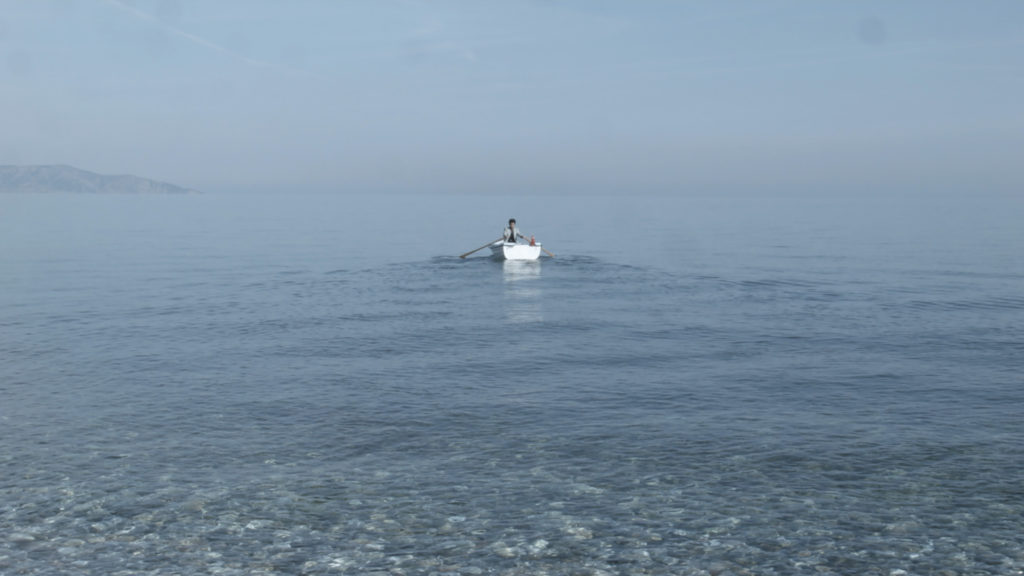
Santiago Mostyn, Citizen (video stills), 2017. Two-channel HD film, wooden oars, framed archival inkjet print. 312 minutes. Stills courtesy of the artist and Andréhn/Schiptjenko, Stockholm
Santiago Mostyn, Citizen (video stills), 2017. Two-channel HD film, wooden oars, framed archival inkjet print. 312 minutes. Stills courtesy of the artist and Andréhn/Schiptjenko, Stockholm
NOTES
1 See Butler’s use of the term ‘modes of living’ in her essay “The Sensibility of Critique: Response to Asad and Mahmood,” in Is Critique Secular? – Blasphemy, Injury, and Free Speech, ed. Talal Asad, Wendy Brown, Judith Butler and Saba Mahmood, Berkeley: The Townsend Center for the Humanities and University of California Press, 2009, p. 134: “At stake is a rethinking of the processes of minoritization under new global conditions, asking what alliances are possible between religious, racial, and sexual minorities (when these ‘positions’ are less identities than modes of living in relation to others and to guiding ideals). Then perhaps we can find constellations where the opposition to racism, to discrimination, to precarity, and to state violence remain the clear goals of political mobilization.”
2 The Miljonprogrammet (Million Programme) was an ambitious public housing programme developed by the governing Swedish Social Democratic Party. Between 1965 and 1974, one million homes were built to address the chronic housing shortage produced by the country’s transformation into an industrial economy. Though utopian in its aspiration, the Programme chose to build in areas largely outside of the town and city centres. Due in large part to the homes’ remoteness, the expected level of class integration did not occur. Instead, these areas have historically been home to migrant communities, leading to their contemporary description as ‘ghettos.’
3 During the biennial and coinciding with Yom Kippur and the Göteborg Book Fair, the neo-Nazi Nordic Resistance Movement held a march through central Gothenburg on September 30, 2017.
4 Coincidentally, 2017 also marked the 500th ‘anniversary’ of the Protestant Reformation.
5 This has been analysed by Lars M. Andersson in his book En jude är en jude är en jude – representationer av “juden” i svensk skämtpress omkring 1900–1930 (A Jew is a Jew is a Jew – Representations of “Jews” in Swedish Satirical Press Between 1900–1930), published by Nordic Academic Press, Lund, 2000. The book is in Swedish with the concluding essay also in English.
6 For example, Kristian Vistrup Madsen’s review for The White Review presents a more complex grasp of the subject: http://www.thewhitereview.org/reviews/gothenburg-biennial-2017-wheredoiendandyoubegin-secularity/. By contrast, Sinziana Ravini’s review for Kunstkritikk posits a more one-dimensional understanding of secularity as freedom of religion: http://www.kunstkritikk.com/kritikk/the-end-of-religion-is-the-beginning-of-art/. See also my response to this review: http://www.kunstkritikk.com/kommentar/in-response-to-the-review-of-the-goteborg-international-biennial-for-contemporary-art-2017/.
7 God is Great (#2) (1991), a work from the Tate collection which comprises a sheet of glass with copies of the Bible, Talmud and Quran embedded in its surface, was to be displayed in an exhibition dedicated to John Latham in 2005. It was vetoed by gallery officials for fear of offending Muslims or of the work being misunderstood in the political climate following the terror attacks in London on July 7 of that year. Rights organisations such as Liberty protested this decision. Latham himself demanded the work be returned to him. A second incident occurred when God is Great (#4) (2005) was defaced during an exhibition at Portikus in Frankfurt in May 2014.
ABOUT THE AUTHOR
Nav Haq is Senior Curator at M HKA — Museum of Contemporary Art Antwerp and an editor for the online platform of L’Internationale, a confederation of European museums, accessible at www.internationaleonline.org.

